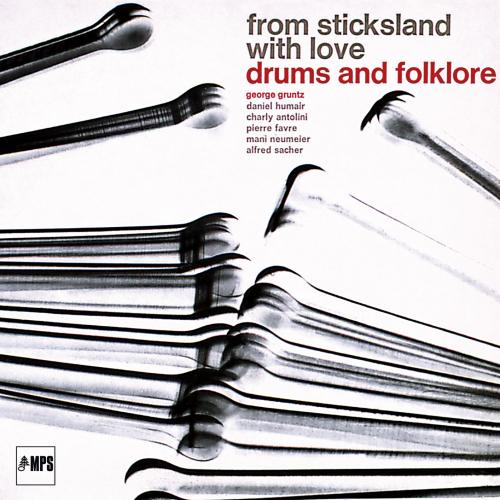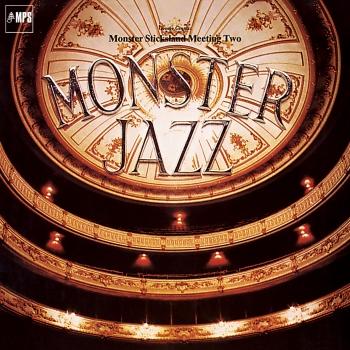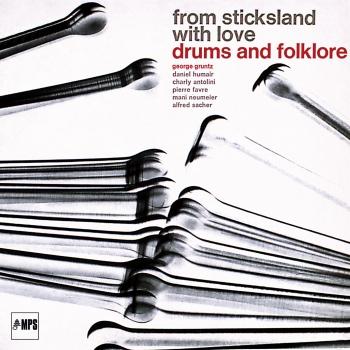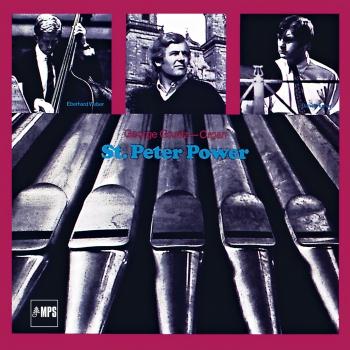
From Sticksland with Love (Remastered) George Gruntz
Album Info
Album Veröffentlichung:
1967
HRA-Veröffentlichung:
10.03.2017
Das Album enthält Albumcover
- 1 D'reemer (Live) 02:31
- 2 From Sticksland with Love (Live) 13:52
- 3 Hightime Keepsakes (Live) 06:54
- 4 Intercourse (Live) 05:52
- 5 Change of Air (Live) 03:38
- 6 Sketches for Percussion (Live) 04:47
- 7 Retraite Celeste (Live) 07:47
Info zu From Sticksland with Love (Remastered)
Part of MPS’s groundbreaking ‘Jazz Meets the World’ series, this 1967 album combines the Basel Carnival tambour and jazz drumming traditions. The Basel tambour band of Alfred Sacher and Georges Mathys’ assemblage of top fife players join up with four internationally renowned Swiss jazz drummers. Presiding over the gathering: pianist-composer-arranger George Gruntz, ‘the perfect mediator’. Sacher’s drum corps lead off with the traditional march D’Reemer (the Romans), a piece whose origins are shrouded in the mist of time. Composed by Gruntz, the title piece introduces the four Swiss jazz drummers. The theme integrates tambour and jazz drum traditions before the four solos – Charlie Antolini professes the swing style of Buddy Rich, Daniel Humair exhibits his ‘melodic’ approach, Pierre Favre shows restraint and a love of symbol colors, and Mani Neumeier takes an eclectic multi-perussion path. The next section features an Antolini-Favre duo followed by Neumeier-Humair. Then there’s Humair disassembling his drum set, a climactic quartet duel, and back to the tambour style. Hightime Keepsakes features Gruntz’s quintet with Favre on drums. The piece runs through a series of motifs and features Nathan Davis’ stunning soprano sax solo. On Intercourse, jazz and the drum corps converse, with the tambour drums trading places with Antolini halfway through each of the bass, trumpet, and sax solos, while on Change of Air the Basel fifers play together with Humair and the jazz rhythm section. Based on lanquenet Marches from the 1499 Swabian War, Gruntz’s Sketches for Percussion exploits the myriad percussive possibilities by combining the tambour and jazz drummers in various groupings. Retraite Celeste (Heavenly Retreat) ends the album in a folkloric tour de force, as the full jazz ensemble along with the Basel drummers and fifers create a finely woven asymmetric percussive tapestry. Joachim E. Berendt captured the album’s importance: “The musical breath of the times swings in records such as these.”
George Gruntz, piano
Nathan Davis, saxophone
Franco Ambrosetti, trumpet
Jimmy Woode, bass
Charly Antolini, drums
Daniel Humair, drums
Mani Neumeier, drums
Pierre Favre, drums
Digitally remastered
George Gruntz
Pianist, Komponist, Bandleader Einer der prominentesten Vertreter des Euro-Jazz 33386George Gruntz, 1932 in Basel geboren, wurde erstmals international bekannt als Mitglied der "Newport International Band" am Newport Jazz Festival 1958, wo er auch Louis Armstrong begleitete (dokumentiert auf CBS Schallplatten).
Während der 60-er Jahre absolvierte Gruntz zahllose Europatourneen, als Pianist mit Jazz-Berühmtheiten wie Dexter Gordon, Roland Kirk, Chet Baker, Johnny Griffin, Gerry Mulligan und Art Farmer. In den Jahren 1968 und 1969 tourte er weltweit zusammen mit der historischen "Phil Woods European Rhythm Machine", welche auch zwei hochdekorierte Schallplatten eingespielt hat.
Die Opéra Paris beauftragte George Gruntz 1973 mit der Komposition einer ersten wirklichen, nur von improvisierenden Jazz-Musikern und -Sängern aufzuführende Jazz-Oper, mit dem Titel "World Jazz Opera". Das Werk entstand in Zusammenarbeit mit dem afroamerikanischen Dichter Amiri Baraka (LeRoi Jones) und wurde am newyorker Off-Broadway-Theater "La Mama Etc." in einer Workshop-Version 1982 uraufgeführt. Einzelne Arien sind auf verschiedenen CDs dokumentiert. Das vorletzte Opernwerk von George Gruntz, "Cosmopolitan Greetings", fand seine Uraufführung 1988 an der Hamburgischen Staatsoper, als Gemeinschaftsproduktion mit dem Dichter Allen Ginsberg, dem Regisseur Robert Wilson und dem Opern-Intendanten Rolf Liebermann (Konzert-Version auf Doppel-CD # MGB CD9203).
George Gruntz arbeitet häufig als Gastdirigent von Radio Big Bands und Sinfonie-Orchestern in ganz Europa. Von 1970 bis 1984 war er musikalischer Oberleiter des Zürcher Schauspielhauses, von 1972 bis 1994 künstlerischer Leiter des Berliner Jazz Festivals (Berliner Jazztage) in der "Philharmonie" und im "Haus der Kulturen der Welt", Berlin.
Als konzertierender Musiker erlangte Gruntz weltweite Bekanntheit und hohe Auszeichnungen mit der 1972 zusammen mit Gérard Lüll (Präsident EUROMUSIC ASSN.) und Schweizer Jazzmusikern gegründeten GEORGE GRUNTZ CONCERT JAZZ BAND (GG-CJB). In den über 30 Jahren ihres Bestehens unternahm die GG-CJB Tourneen durch alle Kontinente der Welt (mit Ausnahme von Australien). 1992 tourte die GG-CJB durch Hauptstädte Chinas, als erste internationale Jazz-Grossformation. Zum 25-Jahre-Jubiläum fanden auch Tourneen durch Russland (ende 1996) und Aegypten (ende 1997) statt. Rund 20 LPs, CDs und ein Buch zum Geburtstag dokumentieren die Arbeit der GG-CJB. 1998 tourte die GG-CJB zweimal durch Europa (Anfang: Weltausstellung Lissabon; "triumphialer" Jahresabschluss auf dem JazzFest Berlin, dokumentiert auf der CD "Liebermann: Live At JazzFest Berlin" - TCB # 99452). Und im Sommer 1998 durch Kanada ("Festival-Gürtel") und die USA (Ravinia-Chicago Festival, "Knitting Factory" New York, etc.). 2003 eine der wenigen, für das Festival SWISS PEAKS NEW YORK erfolgreichen Auftritte im legendären Jazzclub „Birdland“ (drei ausverkaufte Konzerte). 2002 und 2003 „artist/composer in residence“ beim MENUHIN FESTIVAL Gstaad/Switzerland, wo eine Reihe grösserer, neuer Werke entstand: 2002 aufgeführt von der BIG BAND DE LAUSANNE, dem Schweizer Spitzenorchester ORCHESTRE DE LA SUISSE ROMANDE DE LAUSANNE und den Gastsolisten Dave Liebman, Matthieu Michel und Tom Rainey, sowie 2003 eine neue Jazzoper für 8 improvisierende Sänger und Big Band, „The Magic of a Flute“, aufgeführt in Gstaad und am SCHLESWIG HOLSTEIN FESTIVAL in Hamburg/Deutschland.
George Gruntz erhielt zahlreiche nationale und internationale Auszeichnungen; 1995 das "Verdienstkreuz erster Klasse des Verdienstordens der Bundesrepublik Deutschland".
Dieses Album enthält kein Booklet











